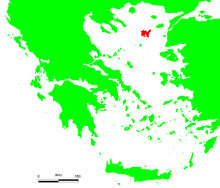Limnio
| Limnio | |
|---|---|
| Grape (Vitis) | |
| Color of berry skin | Noir |
| Species | Vitis vinifera |
| Also called | See list of synonyms |
| Origin | Greece |
| VIVC number | 6835 |
Limnio (LIM-nee-oh) is a red Greek wine grape variety[1] that is indigenous to the Greek island of Lemnos. The grape has had a long history of wine production that may extend back to Ancient Greece with wine historians widely believing it was the grape variety, Lemnia, that was described by Aristotle as producing the famous red Lemnian wine.[2][3] According to wine expert Oz Clarke, Limnio is "One of Greece's most important red vines."[4]
History
[edit]
According to wine expert Jancis Robinson, Limnio was almost certainly the Lemnia grape described by Aristotle as a specialty of the island of Limnos[5]-an assessment shared by other wine experts and historians.[6][7][8] A Limnia grape was also referenced in Ancient Greek writings by Hesiod and Polydeuctes.[9]
Wine regions
[edit]
Today, Limnio is still being produced on Lemnos, though it is not utilized in the appellation wine produced on the island.[4] (Technically the only appellation wine produced on Lemnos is from Muscat of Alexandria[9] According to information by the Union of Agricultural Cooperatives of Lemnos (E.A.S.) the total production of Muscat of Alexandria (white wine), delivered by the producers to the Union, was 2,449 tonnes of grapes, while Limnio (Kalambaki) was 86 tones.)[2] with notable plantings around Mount Athos.[5] It is a principal grape variety in the Playies Melitona Appellation of Origin (A.O.) as well as the Drama TI (a Greek wine region similar to a vin de pays) in Macedonia.[10]
Viticulture and winemaking
[edit]Limnio vines are known for their hardiness and ability to survive harsh droughts. The grapes have the ability to produce high must weights that translates into noticeable alcohol levels. They are generally late ripening with phenols that will produces enhanced herbaceous tones if the grapes are not harvested early. Today it is often blended with Cabernet Sauvignon in Meritage-style wines. Other grape varieties that may be blended with Limnio include Cabernet Franc, Cinsaut, Grenache, Petite Sirah, Merlot, Aghiorgitiko and Xynomavro.[9][10]
Wine styles and food pairing
[edit]As a varietal, Limnio produces full bodied wines with moderate tannins and acidity levels and a distinctive mineral aroma.[11] When blended, Limnio adds color, weight, acidity and an herbal aroma which Oz Clarke describes as reminiscent of bay leaves.[4] Wines made from Limnio are often paired with aged cheeses, game meat and roasted dishes.[12]
Synonyms
[edit]Limnio is also known under the synonyms Kalabaki, Kalambaki, Kalampaki, Lembiotiko, Lemnia, Lemnio, Lemniotico, Lemniotiko, Limniotico, Mavro Limnio, Ntourou Kara, and Ntoyrou Kara.[1]
References
[edit]- ^ a b "Limnio". Vitis International Variety Catalogue. Retrieved 2018-12-05.
- ^ a b J. Robinson Jancis Robinson's Guide to Wine Grapes pg 96 Oxford University Press 1996 ISBN 0-19-860098-4
- ^ Xpat Athens News "Ancient theatre on Limnos opens after 2,500 years Archived 2011-07-18 at the Wayback Machine" December 8th, 2010
- ^ a b c Oz Clarke Encyclopedia of Grapes pg 116-117 Harcourt Books 2001 ISBN 0-15-100714-4
- ^ a b J. Robinson Vines, Grapes & Wines pg 225 Mitchell Beazley 1986 ISBN 1-85732-999-6
- ^ A. Domine (ed.) Wine, pp. 729, Ullmann Publishing, 2008 ISBN 978-3-8331-4611-4
- ^ Dana Facaros and Linda Theodorou "Greece" pg 71. Accessed: December 28th, 2010
- ^ Karen MacNeil "The Wine Bible" pg 72. Accessed: December 28th, 2010
- ^ a b c Greek Winemakers Association "Red Greek Varieties Archived 2004-12-09 at the Wayback Machine" Limnio, Accessed: December 28th, 2010
- ^ a b T. Stevenson "The Sotheby's Wine Encyclopedia" pg 434-436 Dorling Kindersley 2005 ISBN 0-7566-1324-8
- ^ J. Robinson Jancis Robinson's Wine Course Third Edition pg 141 Abbeville Press 2003 ISBN 0-7892-0883-0
- ^ Nestor Imports "Greek Grape Varietals Archived 2014-06-04 at the Wayback Machine" Limnio entry. Accessed: December 28th, 2010
